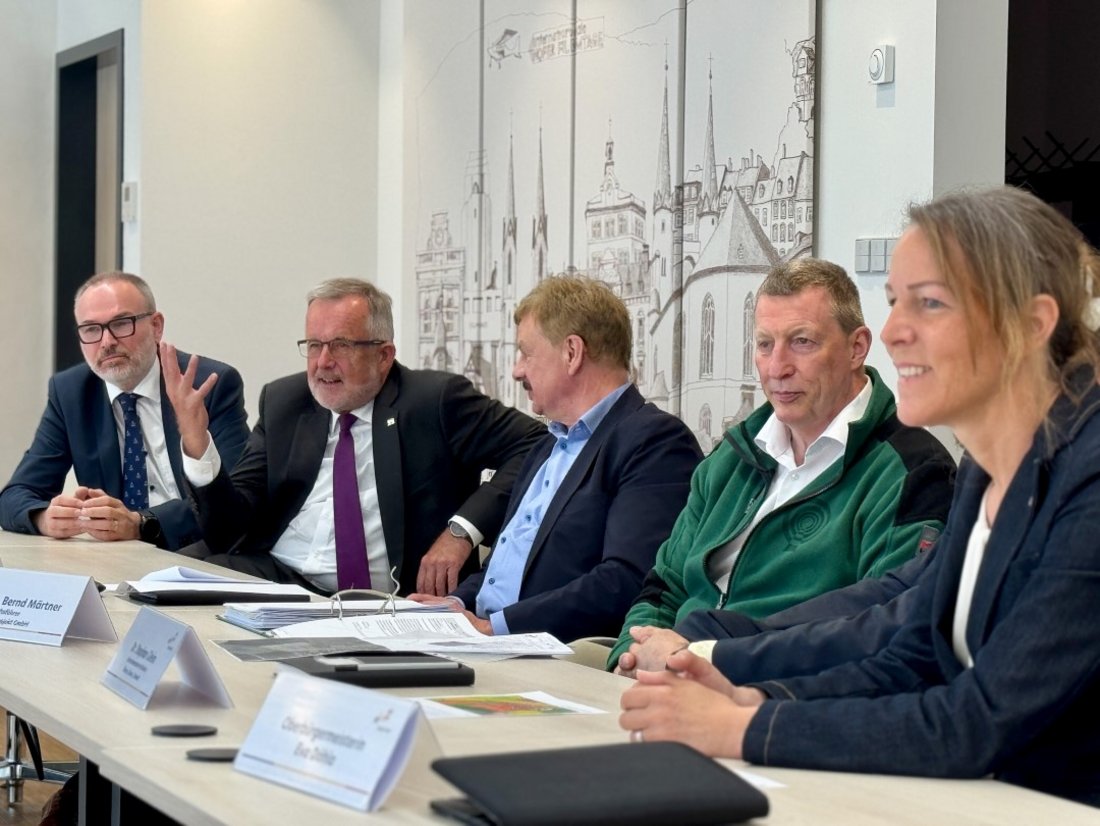Research project for climate-resilient new development area

The city of Hof is launching a pioneering research project together with the Water and Energy Competence Network, Hof University of Applied Sciences (Institute for Sustainable Water and Waste Management - INWA) and M&S Umweltprojekt GmbH from Plauen. The aim is to develop the foundations for a water- and climate-resilient new development area in Hof. The start of the project was presented at a press conference in Hof town hall. The funding decision from the Federal Ministry for the Environment for 400,000 euros was received at the beginning of the year. The project is being funded as part of the "Measures to adapt to the consequences of climate change" program and is scheduled to run for two and a half years.
Response to heavy rainfall, drought and climate change
The project partners made it clear at the press conference that the increasing number of heavy rainfall events, such as those Hof has experienced in the past, as well as the current persistent drought, call for new approaches to dealing with water and land sealing. The aim of the project is to set the course for sustainable, water- and climate-resilient development of the district as early as the preliminary stage of urban land-use planning ("Phase 0").
Mayor Eva Döhla: "We are thus laying the foundations for how modern urban development, climate adaptation and quality of life can go hand in hand - and not just for Hof. Here you can experience science in everyday life. What we are developing at Trappenberg will later serve as a blueprint for construction projects throughout Germany and beyond."
Research with added value for developers
The new development area on Trappenberg will be comparable in size to the Rosenbühl development area next to the Christian Reinhart High School. The research project has direct benefits for those looking to build: By planning ahead for water drainage and storage, considerable long-term cost savings can be achieved for future property owners. Construction Director Stephan Gleim added that, independently of the research project, a further building area on Willy-Brandt-Allee with 15 building plots is already being developed. For the area planned on Trappenberg, the city expects the first homes to be built in five to six years.
Scientific expertise from the region
Professor Jürgen Lehmann, President of Hof University of Applied Sciences, described the project as "forward-looking": "Water is a special competence of our region. We have to learn to manage the water that comes from the sky and the groundwater better." Professor Günter Müller-Czygan, Head of INWA, emphasized that although there are many guidelines for climate-resilient urban districts, there are hardly any implementations that are in line with the requirements of urban land-use planning. This project closes precisely this gap. Walter Friedl, Managing Director of the Water and Energy Competence Network, also sees the project as a model for other municipalities: "We are developing a practical guide that municipalities can use as a basis for their urban land-use planning in the future."
Complex terrain - the perfect challenge
The choice of the Trappenberg as the project location is no coincidence. Bernd Märtner, Managing Director of M&S Umweltprojekt GmbH, explained: "The hillside location, geological features such as rock formations and the proximity to existing residential areas make the site ideal for our project." He referred to innovative approaches in which water is no longer stored on the surface but underground in order to minimize evaporation losses and at the same time use the natural storage capacity of the soil. Märtner emphasized that it is not just a question of coping better with wet and dry periods, but also of safeguarding against crisis scenarios such as an interrupted water supply. "How can we make the new development area as water-resilient as possible? That is the key question for the future."
Hof as a blueprint for climate-resilient construction
The city of Hof sees this project as a great opportunity to provide impetus far beyond the region. The funding body has already certified the project as a beacon project. With an integrated approach to rainwater utilization, infiltration, biodiversity and emergency water supply, a model district will be created on the Trappenberg that shows what sustainable construction can look like. The core of the project is the development of a holistic planning process for the new development area. Instead of isolated measures, the focus is on a networked approach: rainwater management, erosion control, water retention, evaporation, biodiversity and emergency water supply are considered as part of an integrative system. The aim is to anchor the concept of the sponge city in municipal urban land use planning. For the first time, the multi-level analysis developed at Hof University of Applied Sciences is being used to set innovative guidelines for sustainable neighborhood development at the preliminary stage of urban land-use planning ("Phase 0"). This approach could serve as a blueprint for other cities in the future.
Distribution of roles in the project
- The Water and Energy Competence Network is responsible for project management and the final acceptance and transfer analyses.
- M&S Umweltprojekt GmbH is responsible for the inventory analysis of the area and supports other work packages.
- Hof University of Applied Sciences / INWA is contributing the multi-level analysis and developing the methodological basis for phase "0" in urban land use planning.
The research project will run from 1 March 2025 to 31 August 2027. The results will be summarized in a practice-oriented guide and made available to other municipalities.
Further information
- Kompetenznetzwerk Wasser und Energie e.V.: wasser-energie.net
- Hof University of Applied Sciences / INWA: inwa.hof-university.de
- M&S Umweltprojekt GmbH: www.mus-umweltprojekt.de